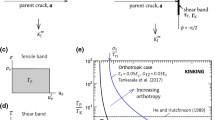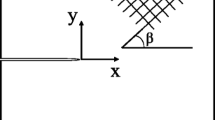Abstract
Fracture of notched, unidirectionally reinforced composite plates with well-bonded ductile matrices is typically preceded by the formation of long, discrete plastic shear zones aligned in the fiber direction. Onset of fracture is associated with a critical tension stress in a certain small process zone ahead of the notch tip; the critical stress is often equal to the tensile strength of the unnotched composite plate. Length of the shear zones can be estimated by plastic limit-analysis, and the local tension stress ahead of the notch found by superposition of the stress caused by remotely applied loads with the stress induced by the shear tractions in the plastic zone, which is shown to be dominated by a logarithmic singularity. In as-fabricated boron-aluminum composites, this fracture mechanism was analyzed and confirmed by numerous experiments (G.J. Dvorak, J. Zarzour and Y. Benveniste, Engineering Fracture Mechanics 42, 501–517, 1992). Since the notch tip field is not described by a stress intensity factor, experimental notched strength data cannot be interpreted in terms of a single material property, such as toughness. An alternative scaling procedure is outlined for prediction of notched strength of wide plates on the basis of data obtained from small size specimens.
Similar content being viewed by others
References
Bahei-El-Din, Y.A., Dvorak, G.J. and Wu, J.F. (1989). Fracture of fibrous metal matrix composites — II. Modeling and numerical analysis. Engineering Fracture Mechanics 34, 105–123. (Paper II)
Bahei-El-Din, Y.A. and Nigam, H. (1990). Fracture of fibrous metal matrix composites — III. Effect of imperfection geometry and heat treatment. Engineering Fracture Mechanics 37, 1207–1232. (Paper III)
Benveniste, Y., Dvorak, G.J., Zarzour, J. and Wung, E.C.J. (1989). On interacting cracks and complex crack configurations in linear elastic media. International Journal of Solids and Structures 25(11) 1279–1293.
Dvorak, G.J., Bahei-El-Din, Y.A. and Bank, L.C. (1989). Fracture of fibrous metal matrix composites — I. Experimental results. Engineering Fracture Mechanics 34, 87–104. (Paper I)
Dvorak, G.J., Zarzour, J. and Benveniste, Y. (1992). Fracture of fibrous metal matrix composites — IV. Plastic zones, local stresses and fracture strength. Engineering Fracture Mechanics 42, 501–517. (Paper IV)
Erdogan, F. (1998). Private communication.
Lekhnitskii, S.G. (1963). Theory of Elasticity of an Anisotropic Elastic Body (Translated by P. Fern), Holden-Day, San Francisco.
Poe, C.C. and Sova, J.A. (1980). Fracture toughness of boron/aluminum laminates with various proportions of 0 and 45 plies. NASA Technical Paper 1707.
Post, D., Czarnek, R., Joh, D., Jo, J. and Guo, Y. (1987). Deformation of a metal matrix tensile coupon with a central slot: An experimental study. Journal of Composite Technology and Research 9, 3–9.
Sih, G.C. and Liebowitz, H. (1968). Mathematical theories of brittle fracture. Fracture (Edited by H. Liebowitz), Vol. II, Chapter 2, Academic Press, New York, 67–190.
Tirosh, J. (1973). The effect of plasticity and crack blunting on stress distribution in orthotropic composite materials. Journal of Applied Mechanics 40, 785–790.
Whitney, J. and Nuismer, R. (1974). Stress fracture criteria for laminated composites containing stress concentrations. Journal of Composite Materials 8, 253–265.
Wieghardt, K. (1907). Über das Spalten und Zerreissen elastischer Körper. Z. Mathematik und Physik 55, 60–103. (See also: Wieghardt, K. (1995). On splitting and cracking of elastic bodies. Fatigue and Fracture of Engineering Materials and Structures 18, 1371–1405, Translated by H.P. Rossmanith.)
Zarzour, J. (1990). Ph.D. Thesis. Rensselaer Polytechnic Institute.
Author information
Authors and Affiliations
Rights and permissions
About this article
Cite this article
Dvorak, G., Suvorov, A. Size effect in fracture of unidirectional composite plates. International Journal of Fracture 95, 89–101 (1999). https://doi.org/10.1023/A:1018687931394
Issue Date:
DOI: https://doi.org/10.1023/A:1018687931394




